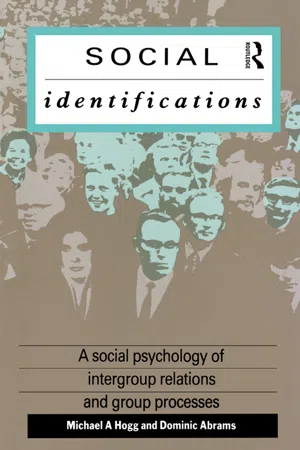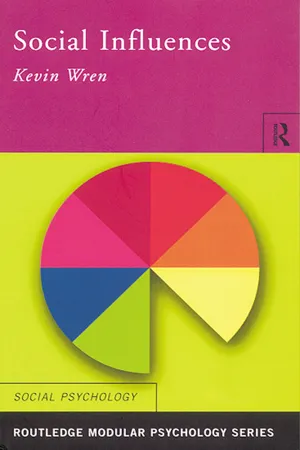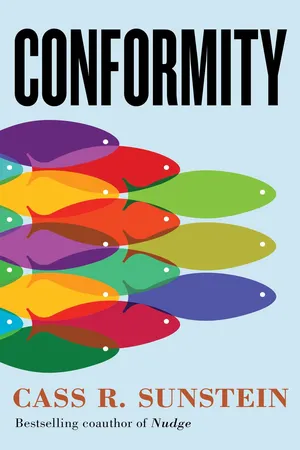Psychology
Conformity
Conformity refers to the tendency of individuals to adjust their thoughts, feelings, and behaviors to align with group norms or expectations. This social influence can lead people to comply with group standards even if it contradicts their personal beliefs or values. Conformity plays a significant role in shaping social behavior and can impact decision-making processes within groups.
Written by Perlego with AI-assistance
Related key terms
9 Key excerpts on "Conformity"
- eBook - ePub
Social Identifications
A Social Psychology of Intergroup Relations and Group Processes
- Dominic Abrams, Michael A. Hogg(Authors)
- 2006(Publication Date)
- Routledge(Publisher)
intra group phenomenon whose analysis must reside in a systematic theoretical treatment of the nature of the social group. We shall build upon this reasoning below when describing the social identity approach to Conformity.Although norms occupy an important position in sociological enquiry, this is not so obvious in social psychology, where the concept, when invoked, is rarely employed in a capacity other than that of common parlance. In experimental social psychology, the consideration of norms is largely restricted to the early work of Sherif (1936), Asch’s Conformity research (Asch 1952), and more recent writings by Rommetveit (1969) and Moscovici (1976). Later, it should become clear that social representations (Farr and Moscovici 1984; Moscovici 1961), social stereotypes and social belief structures (Tajfel 1981b; Tajfel and Turner 1979), orthodoxy (Deconchy 1984), and ideology all have relevance to the concept of norm, as does the entire framework of the self-categorization theory of group behaviour (Hogg and Turner 1987a; Turner 1985; Turner et al. 1987; Wetherell, Turner, and Hogg 1986).Before proceeding it should be emphasized that Conformity can broadly be distinguished from other social influence phenomena in that the behavioural content is normative: it represents a group which it differentiates from other groups and thus contains information about social rather than personal identity. Nevertheless, the very nature of norms is such that most behaviour concerns information about group membership and identity, and hence that most social influence phenomena contain an element of Conformity. For example, compliance with a request to select a book to read (hardly Conformity in any sense other than Conformity to a generic norm for compliance with requests), may contain an element of Conformity to group norms as revealed by the specific choice of book. Similarly, while voting may be compliance with a law (in some countries) that compels voting, voting choice - eBook - ePub
- Kevin Wren(Author)
- 2013(Publication Date)
- Routledge(Publisher)
2
Conformity
Introduction Mustafer Sherif and informational social influences Solomon Asch and normative social influences Informational and normative influences Richard Crutchfield Conformity/non-Conformity and physiology Factors that may influence the degree of Conformity Evaluation of Conformity experiments Explaining the Conformity effect SummaryIntroduction
Throughout our daily lives we conform, i.e. we behave in response to the perceived pressure of others. We queue, wait at bus stops and conform to road signs. In other situations our Conformity is subtler. When in a group we often ‘go with the flow’ while at the same time having some private reservations about what we are doing. In such face-to-face contact with a group we are under pressure to conform to the beliefs, actions and attitudes of the ‘greater’ group. In this respect our behaviour can be governed by a number of social influences of which obedience and Conformity to group influences are examples. We need to be careful here not to confuse behaviour changed as a result of Conformity and behaviour changed as a result of obedience. Although definitions differ slightly from psychologist to psychologist the following differences can be observed:In this chapter we are going to examine material that deals with behaviour altered as a result of manipulating group pressure, i.e. Conformity.• In Conformity situations behaviour changes as a result of group pressure, despite there being no explicit requirement on the part of individual participants to change. In this respect behaviour within the group becomes more homogenous.• In obedience situations behaviour changes as a result of the explicit instructions of an authority figure, i.e. the experimenter. In this respect behaviour arises out of the fact that social structure is differentiated, i.e. the experimenter begins with a higher status. (after Evans, 1980) - eBook - ePub
Social Groups in Action and Interaction
2nd Edition
- Charles Stangor(Author)
- 2015(Publication Date)
- Routledge(Publisher)
4 SOCIAL INFLUENCESocial influence refers to the pressure that we experience to think and behave in ways that are usual and expected within our social groups. Social influence can lead to Conformity, but it doesn’t always. People like to be similar to others, but they also wish to maintain their own distinct personal identity.CONTENTS AT A GLANCESocial Influence Some Examples of Influence Motives for Conformity Informational Conformity Normative Conformity Differentiating Motives for Conformity Majority Influence Solomon Asch’s Line Perception Studies Determinants of Influence Minority Influence Minority Influence in Action Minority Influence and Creative Thinking Comparing Majority and Minority Influence Single-Process Approaches Dual-Process Approaches Summary Alternative Approaches for Minority Group Members Limits of Conformity Personality Variables Gender Differences in Conformity Psychological Reactance and Deviance Chapter Summary Review and Discussion Questions Recommended ReadingAs we saw in Chapter 1 , one of the most fundamental assumptions about social groups is that the members of those groups will be similar to one another, in the sense that they share important values and beliefs. Although this sharing occurs in part because similar individuals are likely to initially join or form groups, similarity is also increased over time, through the tendency for group members to act in ways that lead other group members to become even more similar to each other. The focus of this chapter is on when and how this change—known as social influence—occurs. We will see that social influence is a ubiquitous part of social life, occurring both in small working groups as well as in large social categories.SOCIAL INFLUENCE Social influence - eBook - ePub
- Jane Callaghan, Lisa Lazard(Authors)
- 2011(Publication Date)
- Learning Matters(Publisher)
Chapter 4 , social influence refers to the way that the thoughts, feelings and behaviours of one person (or a group of people) are influenced by the real, imagined or implied presence of other people. Three forms of social influence should be distinguished.- Compliance involves changing your behaviour on the instruction or under the influence of another. It also involves a response to a direct instruction from another person. Compliance differs from persuasion in the sense that compliance targets behaviour change (regardless of shift in attitude), while persuasion is intended to change people’s attitudes.
- Obedience involves compliance with the instructions of an authority figure.
- Conformity involves changing your attitudes or opinions as a result of social pressure. This can include Conformity to the behaviour or a group, Conformity in large groups (crowd behaviour , or what is sometimes termed ‘mob psychology’) and Conformity to social norms.
Think about the way you dress, the way you style your hair, the kind of shoes you wear. How much of this is really individual choice, and to what degree is it influenced by issues such as fitting in, following a style or trend etc.? Even the least fashion-conscious person in the world will often still dress with a sense of what might be appropriate (or if they wish to shock, inappropriate) to the context they are in. We often dress to blend in, or to stand out, but either way there is an element of social influence in our choices. Conformity is often represented as a negative thing – as in the case of ‘peer pressure’. However, is fitting in always a bad thing? To what degree is a level of Conformity necessary for social life?In this chapter, we will consider various social-psychological perspectives on social influence at the individual and at the group level. We will be asking questions such as: what makes us comply with the wishes of others? Why might we obey the instructions of an authority figure? How and why do people conform? How do groups influence our behaviour? What about resistance to Conformity pressures?Compliance and obedience
Compliance involves acceding to the request of another person. The request might be explicit (‘Go to the office and fetch my case’) or implicit (as in the case of some of the less direct forms of social influence considered in Chapter 4 - eBook - ePub
- Richard J. Crisp, Rhiannon N. Turner(Authors)
- 2020(Publication Date)
- SAGE Publications Ltd(Publisher)
5 Social Influence- Social Norms 108
- Norm Development 108
- Conformity 112
- Asch’s Conformity Experiment 113
- Explaining Conformity 114
- Factors that Moderate Conformity 116
- Impact of Influence on Social Norms 120
- Minority Influence 125
- Consistency and Confidence 125
- How Minorities Exert Influence 127
- Obedience 128
- Milgram’s Study of Obedience 128
- Explaining Obedience 130
- Determinants of Obedience 131
- Social Impact Theory 133
- Norms as Nudges 133
- Chapter Summary 134
When, why and how is people’s behaviour influenced by the presence of others? How do other people influence our own behaviour?Social influenceis all about how our thoughts, feelings and behaviours change when in the presence of others. Social influence is an umbrella term. It refers to any effect that another person or group has on your own attitudes and behaviours. In this chapter, two types of social influence will be discussed: Conformity and obedience. Both are concerned with the same outcome: a change in behaviour. They differ in thatConformityis used to describe attitude or behaviour change in response to an implied, rather than explicit, social norm. In contrast,obedienceis attitude or behaviour change in response to a direct, or explicit, order. We will see how both majorities and minorities can exert influence on each other, how there are different motivations for following social norms, and how all these interrelated ideas come together to predict social influence in any given context.Social Norms
Norm Development
Some of the very earliest studies in social psychology were on the topic of social influence. Sherif (1935) carried out a classic study to investigate how groups might come to have what are apparently consensual and homogenized beliefs. His experiment had two phases. Participants were initially led to believe that the experiment concerned ‘visual perception’, although what Sherif was really interested in was the influence that other people in the context had on reported visual perception. Participants were led to a room which was pitch-black except for a small dot of light on the far wall. The participants’ task was to make 100 judgements as to how far the dot was moving in inches. In fact, Sherif was making use of an established perceptual illusion called the ‘autokinetic effect’. This effect makes a dot appear to oscillate in a dark room when there is no other point of reference. Because there was no actual movement of the dot, the autokinetic effect provided an excellent experimental control: any observed effects on participants’ estimations of how far the dot moved could only be attributable to psychological factors. In this first phase when participants individually made their estimates there was, as expected, some variation in different - eBook - ePub
Psychoanalysis, Classic Social Psychology and Moral Living
Let the Conversation Begin
- Paul Marcus(Author)
- 2019(Publication Date)
- Routledge(Publisher)
Social psychologists (Smith et al., 2015, pp. 383–385) have emphasized at least three straightforward, practical ways of fending off heavy-handed, unfair or objectionable social norms within a small group context of equals that an analyst can help cultivate. Such practical skillfulness is an expression of “cultural literacy,” as Pierre Bourdieu called it (1977), a mindfulness of the world in which one is embedded, what amounts to the “sense of the game” that allows a person to effectively respond quasi-automatically in particular situations. More specifically, it is a developed sense of situational awareness that matters most, defined in military contexts as increased awareness of one’s surroundings (time and space) and identification of potential threats and dangerous situations. For example, being mindful of how norms work and how they can be used to subvert a person is critical. Research has shown that when a person perceives how a social norm is being used to influence him, such as to conform to group pressure, it loses its power over his decision-making. Even something as simple as pointing out that one is being asked to comply helps to curtail such scheming tactics (Cialdini, 2008). Psychoanalytically speaking, such individual self-assertion and self-affirmation requires courage and moral conviction.In general, social norms have such a strong interpretive grip on one’s outlook and behavior because of the intense emotional connections between people, connections that “really matter” to a person. For example, in Asch’s experiment the group was perceived as a solidified and cohesive entity, at least in the mind of the naïve subject engaged in a seemingly collective task, and such a condition influenced him toward Conformity. It is a well-known observation that Conformity fosters a feeling of safety and often provides concrete rewards. In general, people prefer warm consensus to their group, community and larger social environs to the distress associated with not conforming. However, when an individual is in such a group setting where social norms are being pressured, or are direct “assault[s] upon self” as Goffman called it (1961, p. 36), the self-assertion and self-affirmation of one’s personal beliefs and values to the group can make a huge difference in terms of avoiding Conformity. In fact, when researchers had some people reflect on their own personal beliefs and values, their behavior was less inclined to follow group norms (Binning et al., 2010). Psychoanalytically speaking, this requires understanding that within a group setting the “tools” of control, power and social governance operate to undermine individual autonomy, integration and humanity. As Michel Foucault noted, “discipline,” the mechanism of power which regulates the behavior of individuals in the social body such as through normalizing judgment “may be identified neither with an institution nor with an apparatus; it is a type of power, a modality for its exercise, comprising a whole set of instruments, techniques, procedures, levels of application, targets; it is a ‘physics’ or an ‘anatomy’ of power, a technology” (1977, p. 215). In the Asch experiment, discipline was meant to bring about individual Conformity through the normalizing judgment of oppressive group pressure. Conceived by Foucault, discipline is one way that power is exercised to make the individual useful and intelligible, manipulatable and analyzable. For the analysand who does not understand how he has been normalized (e.g., homogenized and individualized via a created ideal of behavior) into a strategy of disciplinary power that he does recognize as operative, he is doomed to comply and conform. If, however, he is aware of how these power relations produce different kinds of knowledge (power and knowledge always implicate each other for Foucault) that collect and combine, he has the chance to “push back” and resist Conformity. While power/knowledge relations exist in every society, including in small group settings of equals like in the Asch experiment, they can be criticized and resisted in specific and changing situations in space and time. As Foucault notes, resistance is always a possibility, especially to more subtle situations of group pressure among equals, but only if one is critically aware that Conformity is at play. - eBook - ePub
Conformity
The Power of Social Influences
- Cass R. Sunstein(Author)
- 2019(Publication Date)
- NYU Press(Publisher)
Chapter 1 How Conformity Works Why, and when, do people do what others do? To answer this question, we need to distinguish between hard questions and easy ones. It is reasonable to speculate that when people are confident that they are right, they will be more willing to do what they think best and to reject the views of the crowd. Several sets of experiments confirm this speculation, but they also offer some significant twists. Most important, they suggest three points that I will emphasize throughout: 1. Those who are confident and firm will have particular influence, and can lead otherwise identical groups in dramatically different directions. 2. People are extremely vulnerable to the unanimous views of others, and hence a single dissenter, or voice of sanity, is likely to have a huge impact. 3. If people seem to be from some group we distrust or dislike, or a kind of “out group,” they are far less likely to influence us, even on the simplest questions. 1 Indeed, we might say or do the very opposite (“reactive devaluation”). And if people are part of a group to which we also belong, they are far more likely to influence us, on both easy and hard questions. Bonds of affection have a large impact on how we react to what others say and do. I shall have a fair bit to say about ordinary life, but my ultimate goal is to see how these points bear on policy and law. Let us begin by reviewing some classic studies. Hard Questions In the 1930s, the psychologist Muzafer Sherif conducted some simple experiments on sensory perception. 2 Subjects were placed in a very dark room, and a small pinpoint of light was positioned at some distance in front of them. Because of a perceptual illusion, the light, which was actually stationary, appeared to move. On each of several trials, Sherif asked people to estimate the distance that the light had moved. When polled individually, subjects did not agree with one another, and their answers varied from one trial to another - eBook - ePub
- Ian Stuart-Hamilton(Author)
- 1999(Publication Date)
- Jessica Kingsley Publishers(Publisher)
CHAPTER 4 Social PsychologyIntroductionMany branches of psychology are concerned with the individual. Either they are concerned with how and why he or she is different from others (e.g. individual differences, mental illness) or how the mind of the individual works (e.g. memory). However, humans are also social creatures, and social psychology is the study of how people interact socially. Arguably, most psychology students are initially attracted to the subject because of one of the applied branches, but it is social psychology which later captures their attention. In part this may be a reaction against the perceived arid nature of many of the other branches of the discipline, with their emphasis on detailed examinations of aspects of mental behaviour which are in everyday life uninteresting (e.g. how we recognise shapes, how we remember lists of numbers, etc). In contrast, social psychology covers many topics which are fascinating in themselves, such as how we make friends and fall in love, or why people join particular groups or cults. In this chapter, an overview of some of the most popular and frequently-cited topics will be given. As with any introductory chapter, not all areas will be covered and those left out are not necessarily of less importance. For those readers interested in pursuing matters further, a reading list is provided at the end of the chapter.Conformity, compliance and obedienceOne of the key questions in social psychology is the extent to which people will follow other people’s wishes. Clearly psychologists have not found a foolproof method of doing this, or the world would be controlled by psychologists. However, it would appear that several core methods describe many instances in which people can be made to follow a desired path. These are often categorised into Conformity (adapting one’s behaviour to ‘fit in’ with a particular group’s code of conduct), compliance (adapting one’s behaviour following a request by another person) and obedience (adapting one’s behaviour following a command - eBook - ePub
- Nicky Hayes(Author)
- 2017(Publication Date)
- Routledge(Publisher)
On most trials, the information given fitted with the correct answer. But sometimes, the lights indicating other people’s responses implied that everyone else had made the same wrong judgement. On these occasions, Crutchfield found a surprisingly high degree of Conformity — roughly 50 per cent of the participants gave a conforming but wrong answer at some point in the study. So even though they were alone and not confronting others, there was still pressure to conform. Since it involved military personnel, who may have placed a higher emphasis on Conformity than others, Crutchfield’s study may have given more extreme results; but it does imply that there is more to social Conformity than simply avoiding having open disagreements with other people in a face-to-face situation.Key TermsThe process of going along with other people and acting in the same way that they do.ConformityCompliance and social influence
Kelman (1958) discussed how going along with others, or social Conformity, might reflect any of three different processes:compliance, or going along with others but retaining one’s differing private beliefs;internalisation, or agreeing that the other view is more valid; andidentification, or actually changing one’s own mind and agreeing with the other person, usually because the other person is someone they respect or admire.Asch’s participants, Kelman argued, were clearly showing compliance to the group. However, later interviews showed that they had not internalised the other people’s views. Sherif’s original participants, on the other hand, did seem to have internalised their group’s norms, because they stuck with the group judgement even when they were tested alone later. Kelman proposed that it was the ambiguity of the Sherif situation which led to that internalisation.In 1976, Moscovici argued that the Asch experiments were seriously inadequate as a way of exploring social influence, because they were too limited. Essentially, the research participant could either conform to the majority or not, and they were not able to influence others, as would have been the case in real life. When Moscovici and Faucheux (1972) re-analysed Asch’s data, they concluded that the consistency of the judgements made by the stooges was what mostly influenced the research participants. As we saw in the last chapter, Moscovici had already shown how minorities as well as majorities can influence groups — particularly if they put over their ideas in a consistent fashion.
Index pages curate the most relevant extracts from our library of academic textbooks. They’ve been created using an in-house natural language model (NLM), each adding context and meaning to key research topics.








